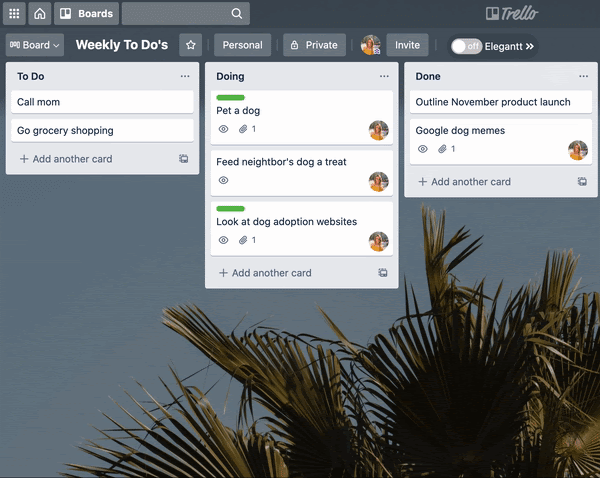There’s nothing worse than wasting time by wading through the weeds of past projects, trying to uncover that flash of inspiration you knew would come in handy at a later date.
But. Where. Is. That. CARD?!
Avid Trello teams and users often have 10, 20, even 30 or more boards that they work within daily. So when it comes to finding that *one* specific card amidst a sea of similarly titled cards, a headache is sure to ensue. Luckily, you don’t need a compass—these built-in search tools will enable you to find a card in Trello faster and more effectively.
How To Search For Boards And Cards In Trello
If your boards are extra-busy visually and searching through lists becomes tedious, just type in a keyword of the card title that you’re searching for in the search box, and a list of cards across all boards with that title keyword will display.

The Little-Known Keyboard Shortcut for Trello Search
Instead of locating the search bar (located in the top-left area of your board) and clicking on it, simply open up a board in your browser, and tap the forward-slash key “/” (or solidus, for you technical folks).
Now feast your eyes upon the cursor that has been ever so swiftly placed into the search field for you, awaiting your swift fingers to input inquisitive queries. No mouse movement required. Pocket that shortcut for later, because destiny and knowledge await.
In other words—save yourself a click and start searching right away with this handy keyboard shortcut.
Trello’s Search Operators
Sure, a keyboard shortcut is great for shaving seconds off of every search, but what good is that if you can’t actually find what you are looking for? That’s why Trello has an awesome team of friends we’d like to introduce you to the search operators.
Search operators refine your search to help you find specific cards and create highly tailored lists. Trello will suggest operators for you as you type, but here are some to get you started:
- @name – Finds cards assigned to a member with that username. If you start typing @, Trello will suggest members for you. member: also works. @me will find only your cards.
- has:attachments – Finds cards with attachments. has:description, has:cover, has:members, and has:stickers also work as you would expect.
- due:day – Finds cards due within 24 hours. due:week finds cards that are due within the following 7 days. due:month, and due:overdue also work as expected. You can search for a specific day range. For example, adding due:14 to search will include cards due in the next 14 days. You can also search for due:complete or due:incomplete to search for due dates that are marked as complete or incomplete.
- label: – Finds labeled cards.
- board:id – Finds cards within a specific board. If you start typing board:, Trello will suggest boards for you. You can search by board name, too, such as “board:trello” to search only cards on boards with trello in the board name.
- created:day – Finds cards created in the last 24 hours. created:week and created:month also work as expected. You can search for a specific day range. For example, adding created:14 to the search will include cards created in the last 14 days.
How To View Saved Searches In Trello
Sometimes searching for the same card on the regular and typing in all those operators again and again can get a little cumbersome. Fear not, Trello has got your back. If you have Business Class, then you have the Saved Search feature on your boards.
Anytime you want to save a search for the future you simply perform that search and then click the “Save this Search” link at the top of the search window.
This feature is great for compiling reports on the fly. For instance, let’s say you want to see all of the high-priority tasks that your team accomplished this week on a big project. Create a search for board:”Project Awesome” label:”high priority” list:”Done” edited:”week”. Now go dole out some serious high-fives to your team for their superior levels of productivity.
Bonus: Saved searches can be organized however you want by simply dragging and dropping them into place. Score!
What’s The Difference Between Searching And Filtering In Trello?
If you want only specific types of cards to be displayed on a Trello board and to remove the rest from view, then the filter feature may be a better option for you. Filtering on a board allows you to focus on specific labels, members assigned to cards, due dates, and keywords.
To access this functionality, click “Show Menu” on your Trello board then click “Search Cards.” You can also press the “F” key to instantly pull up this menu. You’ll then see the options to search on this specific board by labels, members assigned to cards, due dates, and keywords.
For instance, if you’d like to only view cards on your board that are dog-related, simply select the Label “Dog-related”, and the non-related cards will disappear. You can see the number of hidden cards listed beneath the list title. To get those cards back, uncheck the filter.
So put that digital compass and map away—with these Trello search tips, you’ll be able to easily locate those pesky cards that seem to float into the oblivion of your boards.
Editor’s Note: This article was originally published in 2015 and we’ve added a whole heap of new ideas and nuggets of information to this post in October 2020.
Good or bad, we’d love to hear your thoughts. Find us on Twitter (@trello)!
Next Up: 5 Best Practices For Setting Up Effective Trello Boards
